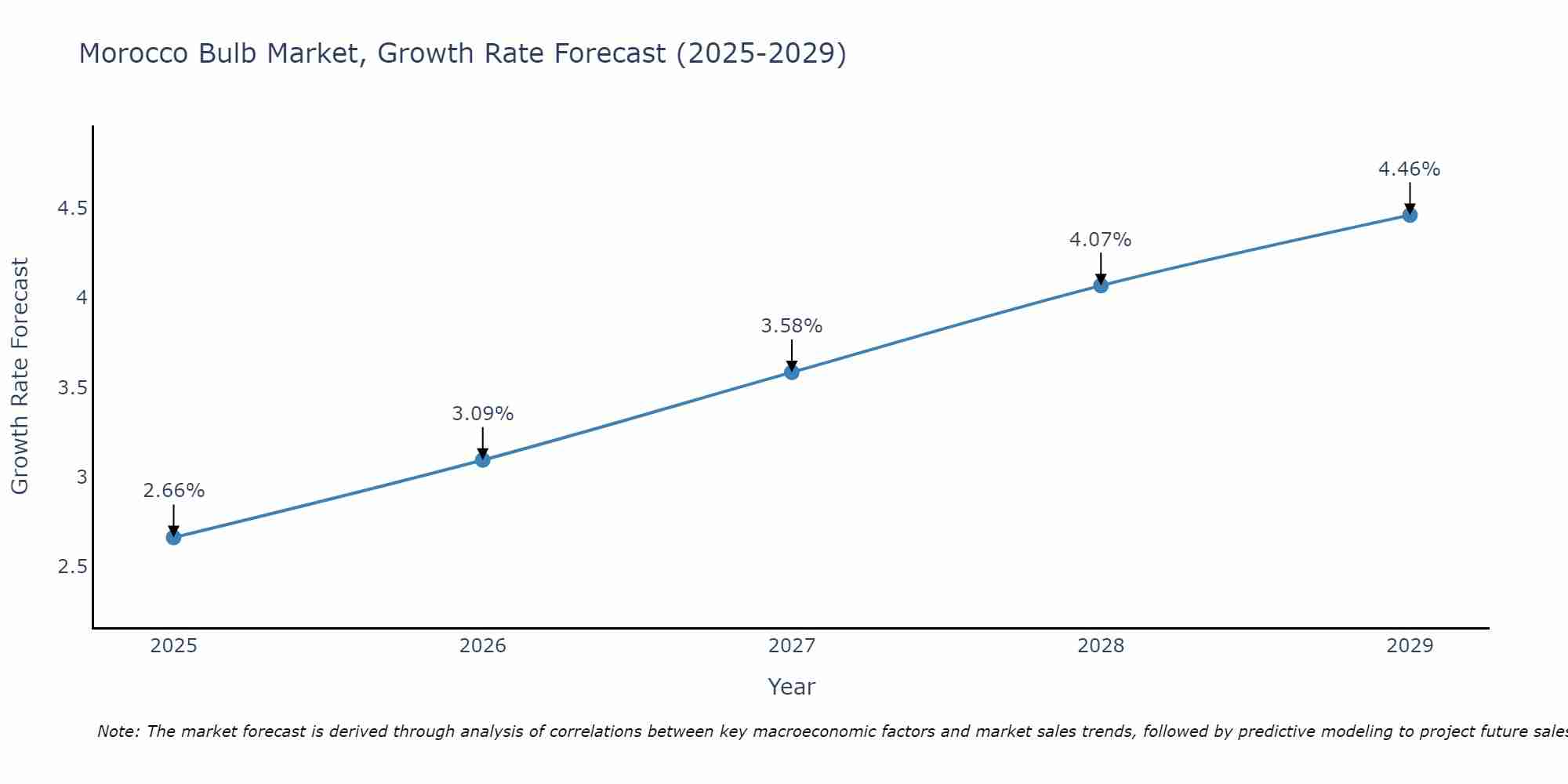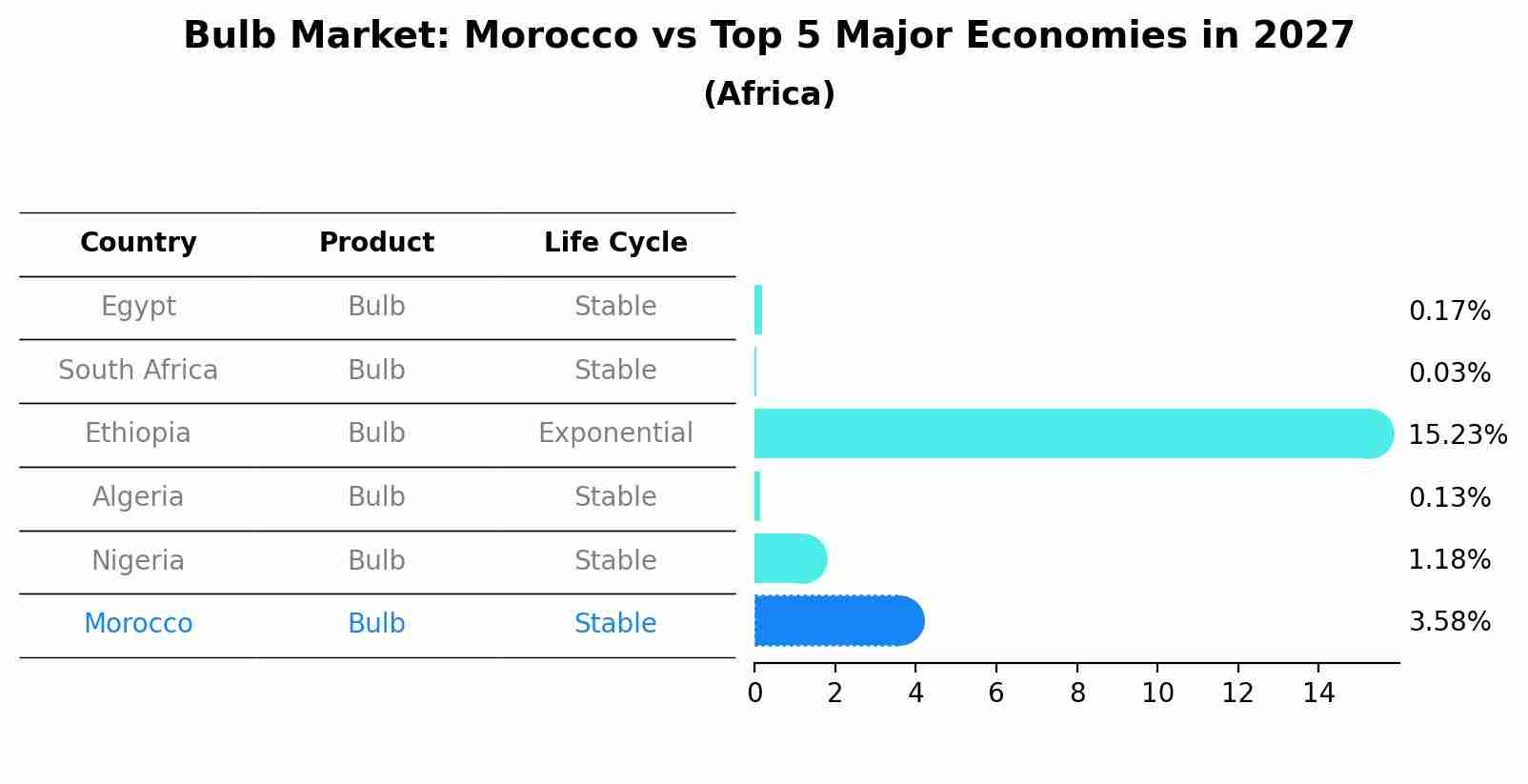Morocco Bulb Market Outlook | Value, Growth, Share, COVID-19 IMPACT, Size, Analysis, Revenue, Industry, Companies, Forecast & Trends
| Product Code: ETC258773 | Publication Date: Aug 2022 | Updated Date: Aug 2025 | Product Type: Market Research Report | |
| Publisher: 6Wresearch | Author: Ravi Bhandari | No. of Pages: 75 | No. of Figures: 35 | No. of Tables: 20 |
Morocco Bulb Market Size Growth Rate
The Morocco Bulb Market is poised for steady growth rate improvements from 2025 to 2029. From 2.66% in 2025, the growth rate steadily ascends to 4.46% in 2029.

Bulb Market: Morocco vs Top 5 Major Economies in 2027 (Africa)
By 2027, Morocco's Bulb market is forecasted to achieve a stable growth rate of 3.58%, with Egypt leading the Africa region, followed by South Africa, Ethiopia, Algeria and Nigeria.

Morocco Bulb Market Synopsis
In the realm of lighting, the bulb market in Morocco is undergoing transformation, driven by the transition towards energy-efficient lighting technologies such as LED bulbs. LED bulbs offer significant energy savings, longer lifespan, and superior performance compared to traditional incandescent and fluorescent bulbs. With increasing awareness about energy conservation and government initiatives promoting the adoption of LED lighting, the bulb market in Morocco is witnessing a shift towards sustainable lighting solutions.
Drivers of the market
The bulb market in Morocco is influenced by factors such as urbanization, population growth, and government initiatives promoting energy-efficient lighting solutions. With the gradual phasing out of inefficient incandescent bulbs and the adoption of LED technology, the market is witnessing a shift towards more sustainable and cost-effective lighting options. Additionally, rising disposable incomes and changing consumer preferences are driving the demand for advanced lighting products in both residential and commercial segments.
Challenges of the market
The bulb market in Morocco faces several issues, including competition from energy-efficient lighting solutions such as LEDs, which are gradually replacing traditional bulbs. There is also a significant influx of low-cost, low-quality bulbs in the market, which affects consumer trust and market stability. The lack of stringent regulations and standards for lighting products further exacerbates this problem. Additionally, consumer awareness about the long-term cost savings and environmental benefits of energy-efficient bulbs remains low, hindering market growth.
Government Policy of the market
Energy efficiency policies in Morocco have driven the market for energy-saving bulbs, such as LEDs. The government has phased out the use of incandescent bulbs and offers incentives for the production and import of energy-efficient lighting solutions. Public awareness campaigns about the benefits of energy-saving bulbs are also part of the governments efforts to promote sustainable energy use.
Key Highlights of the Report:
- Morocco Bulb Market Outlook
- Market Size of Morocco Bulb Market, 2024
- Forecast of Morocco Bulb Market, 2031
- Historical Data and Forecast of Morocco Bulb Revenues & Volume for the Period 2018 - 2031
- Morocco Bulb Market Trend Evolution
- Morocco Bulb Market Drivers and Challenges
- Morocco Bulb Price Trends
- Morocco Bulb Porter's Five Forces
- Morocco Bulb Industry Life Cycle
- Historical Data and Forecast of Morocco Bulb Market Revenues & Volume By Type for the Period 2018 - 2031
- Historical Data and Forecast of Morocco Bulb Market Revenues & Volume By Incandescent Bulbs for the Period 2018 - 2031
- Historical Data and Forecast of Morocco Bulb Market Revenues & Volume By Fluorescent Bulbs for the Period 2018 - 2031
- Historical Data and Forecast of Morocco Bulb Market Revenues & Volume By CFLs for the Period 2018 - 2031
- Historical Data and Forecast of Morocco Bulb Market Revenues & Volume By Halogens for the Period 2018 - 2031
- Historical Data and Forecast of Morocco Bulb Market Revenues & Volume By LEDs for the Period 2018 - 2031
- Historical Data and Forecast of Morocco Bulb Market Revenues & Volume By Application for the Period 2018 - 2031
- Historical Data and Forecast of Morocco Bulb Market Revenues & Volume By Lamps & Light Bulbs for the Period 2018 - 2031
- Historical Data and Forecast of Morocco Bulb Market Revenues & Volume By Operation Theatre (OT Instruments) for the Period 2018 - 2031
- Historical Data and Forecast of Morocco Bulb Market Revenues & Volume By Torchlights and Flashlights for the Period 2018 - 2031
- Historical Data and Forecast of Morocco Bulb Market Revenues & Volume By Automobile Headlights for the Period 2018 - 2031
- Historical Data and Forecast of Morocco Bulb Market Revenues & Volume By Mining Headgears for the Period 2018 - 2031
- Historical Data and Forecast of Morocco Bulb Market Revenues & Volume By Others for the Period 2018 - 2031
- Morocco Bulb Import Export Trade Statistics
- Market Opportunity Assessment By Type
- Market Opportunity Assessment By Application
- Morocco Bulb Top Companies Market Share
- Morocco Bulb Competitive Benchmarking By Technical and Operational Parameters
- Morocco Bulb Company Profiles
- Morocco Bulb Key Strategic Recommendations
Frequently Asked Questions About the Market Study (FAQs):
1 Executive Summary |
2 Introduction |
2.1 Key Highlights of the Report |
2.2 Report Description |
2.3 Market Scope & Segmentation |
2.4 Research Methodology |
2.5 Assumptions |
3 Morocco Bulb Market Overview |
3.1 Morocco Country Macro Economic Indicators |
3.2 Morocco Bulb Market Revenues & Volume, 2021 & 2031F |
3.3 Morocco Bulb Market - Industry Life Cycle |
3.4 Morocco Bulb Market - Porter's Five Forces |
3.5 Morocco Bulb Market Revenues & Volume Share, By Type, 2021 & 2031F |
3.6 Morocco Bulb Market Revenues & Volume Share, By Application, 2021 & 2031F |
4 Morocco Bulb Market Dynamics |
4.1 Impact Analysis |
4.2 Market Drivers |
4.2.1 Growing demand for energy-efficient lighting solutions |
4.2.2 Government initiatives promoting the use of LED bulbs for energy conservation |
4.2.3 Increasing awareness about environmental sustainability and carbon footprint reduction |
4.3 Market Restraints |
4.3.1 Price volatility of raw materials affecting production costs |
4.3.2 Competition from alternative lighting technologies |
4.3.3 Lack of awareness among the rural population about the benefits of LED bulbs |
5 Morocco Bulb Market Trends |
6 Morocco Bulb Market, By Types |
6.1 Morocco Bulb Market, By Type |
6.1.1 Overview and Analysis |
6.1.2 Morocco Bulb Market Revenues & Volume, By Type, 2021-2031F |
6.1.3 Morocco Bulb Market Revenues & Volume, By Incandescent Bulbs, 2021-2031F |
6.1.4 Morocco Bulb Market Revenues & Volume, By Fluorescent Bulbs, 2021-2031F |
6.1.5 Morocco Bulb Market Revenues & Volume, By CFLs, 2021-2031F |
6.1.6 Morocco Bulb Market Revenues & Volume, By Halogens, 2021-2031F |
6.1.7 Morocco Bulb Market Revenues & Volume, By LEDs, 2021-2031F |
6.2 Morocco Bulb Market, By Application |
6.2.1 Overview and Analysis |
6.2.2 Morocco Bulb Market Revenues & Volume, By Lamps & Light Bulbs, 2021-2031F |
6.2.3 Morocco Bulb Market Revenues & Volume, By Operation Theatre (OT Instruments), 2021-2031F |
6.2.4 Morocco Bulb Market Revenues & Volume, By Torchlights and Flashlights, 2021-2031F |
6.2.5 Morocco Bulb Market Revenues & Volume, By Automobile Headlights, 2021-2031F |
6.2.6 Morocco Bulb Market Revenues & Volume, By Mining Headgears, 2021-2031F |
6.2.7 Morocco Bulb Market Revenues & Volume, By Others, 2021-2031F |
7 Morocco Bulb Market Import-Export Trade Statistics |
7.1 Morocco Bulb Market Export to Major Countries |
7.2 Morocco Bulb Market Imports from Major Countries |
8 Morocco Bulb Market Key Performance Indicators |
8.1 Number of energy-efficient lighting installations in residential and commercial sectors |
8.2 Average energy savings per household or business using LED bulbs |
8.3 Percentage of government projects using LED lighting solutions |
8.4 Adoption rate of LED bulbs in urban areas |
8.5 Number of awareness campaigns conducted on the benefits of energy-efficient lighting |
9 Morocco Bulb Market - Opportunity Assessment |
9.1 Morocco Bulb Market Opportunity Assessment, By Type, 2021 & 2031F |
9.2 Morocco Bulb Market Opportunity Assessment, By Application, 2021 & 2031F |
10 Morocco Bulb Market - Competitive Landscape |
10.1 Morocco Bulb Market Revenue Share, By Companies, 2024 |
10.2 Morocco Bulb Market Competitive Benchmarking, By Operating and Technical Parameters |
11 Company Profiles |
12 Recommendations |
13 Disclaimer |
- Single User License$ 1,995
- Department License$ 2,400
- Site License$ 3,120
- Global License$ 3,795
Search
Related Reports
- Portugal Electronic Document Management Market (2025-2031) | Strategy, Consumer Insights, Analysis, Investment Trends, Opportunities, Growth, Size, Share, Industry, Revenue, Segments, Value, Segmentation, Supply, Forecast, Restraints, Outlook, Competition, Drivers, Trends, Demand, Pricing Analysis, Competitive, Strategic Insights, Companies, Challenges
- France Electronic Document Management Market (2025-2031) | Strategy, Consumer Insights, Analysis, Investment Trends, Opportunities, Growth, Size, Share, Industry, Revenue, Segments, Value, Segmentation, Supply, Forecast, Restraints, Outlook, Competition, Drivers, Trends, Demand, Pricing Analysis, Competitive, Strategic Insights, Companies, Challenges
- Portugal Occupational Health & Safety Services Market (2025-2031) | Strategy, Consumer Insights, Analysis, Investment Trends, Opportunities, Growth, Size, Share, Industry, Revenue, Segments, Value, Segmentation, Supply, Forecast, Restraints, Outlook, Competition, Drivers, Trends, Demand, Pricing Analysis, Competitive, Strategic Insights, Companies, Challenges
- Netherlands Occupational Health and Safety Services Market (2025-2031) | Strategy, Consumer Insights, Analysis, Investment Trends, Opportunities, Growth, Size, Share, Industry, Revenue, Segments, Value, Segmentation, Supply, Forecast, Restraints, Outlook, Competition, Drivers, Trends, Demand, Pricing Analysis, Competitive, Strategic Insights, Companies, Challenges
- Belgium and Luxembourg Facility Management Market (2025-2031) | Strategy, Consumer Insights, Analysis, Investment Trends, Opportunities, Growth, Size, Share, Industry, Revenue, Segments, Value, Segmentation, Supply, Forecast, Restraints, Outlook, Competition, Drivers, Trends, Demand, Pricing Analysis, Competitive, Strategic Insights, Companies, Challenges
- Russia Women Intimate Apparel Market (2025-2031) | Strategy, Consumer Insights, Analysis, Investment Trends, Opportunities, Growth, Size, Share, Industry, Revenue, Segments, Value, Segmentation, Supply, Forecast, Restraints, Outlook, Competition, Drivers, Trends, Demand, Pricing Analysis, Competitive, Strategic Insights, Companies, Challenges
- Africa Chocolate Market (2025-2031) | Size, Share, Trends, Growth, Revenue, Analysis, Forecast, industry & Outlook
- Global Hydroxychloroquine And Chloroquine Market (2025-2031) | Industry, Trends, Size, Outlook, Growth, Value, Companies, Revenue, Analysis, Share, Forecast
- Saudi Arabia Plant Maintenance Market (2025-2031) | Industry, Size, Growth, Revenue, Value, Companies, Forecast, Analysis, Share & Trends
- Taiwan Electric Truck Market (2025-2031) | Outlook, Industry, Revenue, Size, Forecast, Growth, Analysis, Share, Companies, Value & Trends
Industry Events and Analyst Meet
Our Clients
Whitepaper
- Middle East & Africa Commercial Security Market Click here to view more.
- Middle East & Africa Fire Safety Systems & Equipment Market Click here to view more.
- GCC Drone Market Click here to view more.
- Middle East Lighting Fixture Market Click here to view more.
- GCC Physical & Perimeter Security Market Click here to view more.
6WResearch In News
- Doha a strategic location for EV manufacturing hub: IPA Qatar
- Demand for luxury TVs surging in the GCC, says Samsung
- Empowering Growth: The Thriving Journey of Bangladesh’s Cable Industry
- Demand for luxury TVs surging in the GCC, says Samsung
- Video call with a traditional healer? Once unthinkable, it’s now common in South Africa
- Intelligent Buildings To Smooth GCC’s Path To Net Zero













